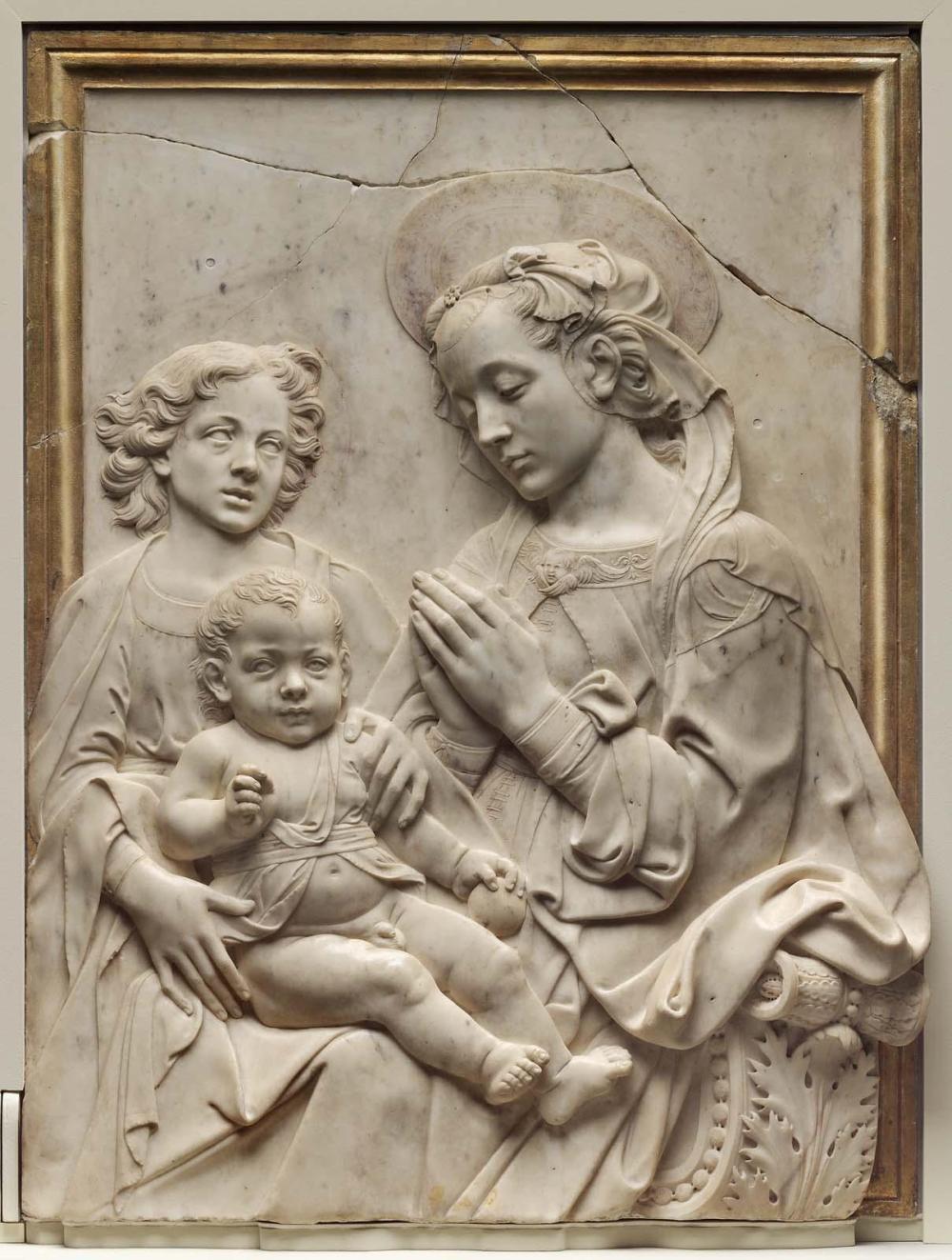Advanced Search
Virgin Adoring the Child
Attributed to: Francesco di Simone Ferrucci (Italian, 1437–1493)
Italian
about 1470–93
Object Place: Europe, Florence, Italy
Medium/Technique
Stone; Marble
Dimensions
Overall: 97.8 × 74.9 × 16.5 cm (38 1/2 × 29 1/2 × 6 1/2 in.)
Diameter and weight: 133.81 kg (295 lb.)
Diameter and weight: 133.81 kg (295 lb.)
Credit Line
Gift of Quincy Adams Shaw through Quincy Adams Shaw, Jr., and Mrs. Marian Shaw Haughton
Accession Number17.1467
NOT ON VIEW
CollectionsEurope
ClassificationsSculpture
DescriptionMarble relief.
ProvenanceBy the 17th century, on the altar at the chapel of the Berzighelli Villa, Capannoli, Italy; 19th century, removed from the altar [see note 1] and, between 1870 and 1879, sold by the owners of the Villa, Francesco Del Rosso and Olivo Masi, to Stefano Bardini (dealer; b. 1836 - d. 1922), Florence [see note 2]; 1879, sold by Bardini to Quincy Adams Shaw (b. 1825 - d. 1908), Boston; 1917, gift of Quincy Adams Shaw, through Quincy Adams Shaw Jr. and Mrs. Marian Shaw Haughton, to the MFA. (Accession Date: March 29, 1917)
NOTES:
[1] In his Notizie dei Professori del Disegno (Florence, 1846 [orig. 1681-1728]) 491-492, Filippo Baldinucci (b. 1625 – d. 1696) described the relief on the altar (“The Virgin and Child, with Archangel Gabriel”) framed between two alabaster columns, and attributed it to Desiderio da Settignano. An 1804 line drawing by Abate Branchini records the relief there. See Benozzo Gianetti, Capannoli, Santo Pietro S. Marco, Camugliano: Castelli della Valdera (2000), 73. When Wilhelm Bode published the relief in Italianische Bildhauer der Renaissance (Berlin, 1887), 97-98, he said that he found it in a villa near Pontadera in 1875. Bode said, in a separate statement, that it had been at a villa owned by the Medici decades earlier, and that it had been “excavated”. Bode’s information is not accurate; the two alabaster columns that framed the relief were believed to have been excavated when the Berzighelli Villa was being renovated. Today, a nineteenth-century replica of the MFA relief is kept at the Villa. See Luciano Migliaccio and Franco Paliaga, “Nuovi Studi su Felice Palma,” Paragone 479-480 (1990), fig. 13.
[2] Stefano Bardini began attempts to acquire the relief around 1870. Olivo Masi backed out of the deal, and Bardini sued the owners in 1874, ultimately prevailing in 1879. In June of that year, Shaw wrote to Bardini to tell him that the relief had arrived. Wilhelm Bode, who published the relief in 1887 (as above, n. 1), also had hoped to acquire it, but he did not. Many thanks to Lynn Catterson for providing this information, taken from her article “Art Market, Social Network and Contamination” (forthcoming).
NOTES:
[1] In his Notizie dei Professori del Disegno (Florence, 1846 [orig. 1681-1728]) 491-492, Filippo Baldinucci (b. 1625 – d. 1696) described the relief on the altar (“The Virgin and Child, with Archangel Gabriel”) framed between two alabaster columns, and attributed it to Desiderio da Settignano. An 1804 line drawing by Abate Branchini records the relief there. See Benozzo Gianetti, Capannoli, Santo Pietro S. Marco, Camugliano: Castelli della Valdera (2000), 73. When Wilhelm Bode published the relief in Italianische Bildhauer der Renaissance (Berlin, 1887), 97-98, he said that he found it in a villa near Pontadera in 1875. Bode said, in a separate statement, that it had been at a villa owned by the Medici decades earlier, and that it had been “excavated”. Bode’s information is not accurate; the two alabaster columns that framed the relief were believed to have been excavated when the Berzighelli Villa was being renovated. Today, a nineteenth-century replica of the MFA relief is kept at the Villa. See Luciano Migliaccio and Franco Paliaga, “Nuovi Studi su Felice Palma,” Paragone 479-480 (1990), fig. 13.
[2] Stefano Bardini began attempts to acquire the relief around 1870. Olivo Masi backed out of the deal, and Bardini sued the owners in 1874, ultimately prevailing in 1879. In June of that year, Shaw wrote to Bardini to tell him that the relief had arrived. Wilhelm Bode, who published the relief in 1887 (as above, n. 1), also had hoped to acquire it, but he did not. Many thanks to Lynn Catterson for providing this information, taken from her article “Art Market, Social Network and Contamination” (forthcoming).




